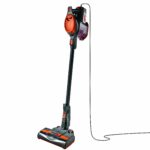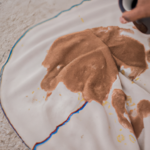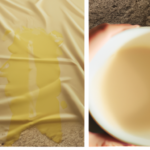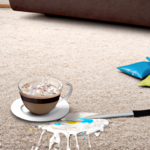Carpet
How Long Does It Take Carpet to Dry After Cleaning?
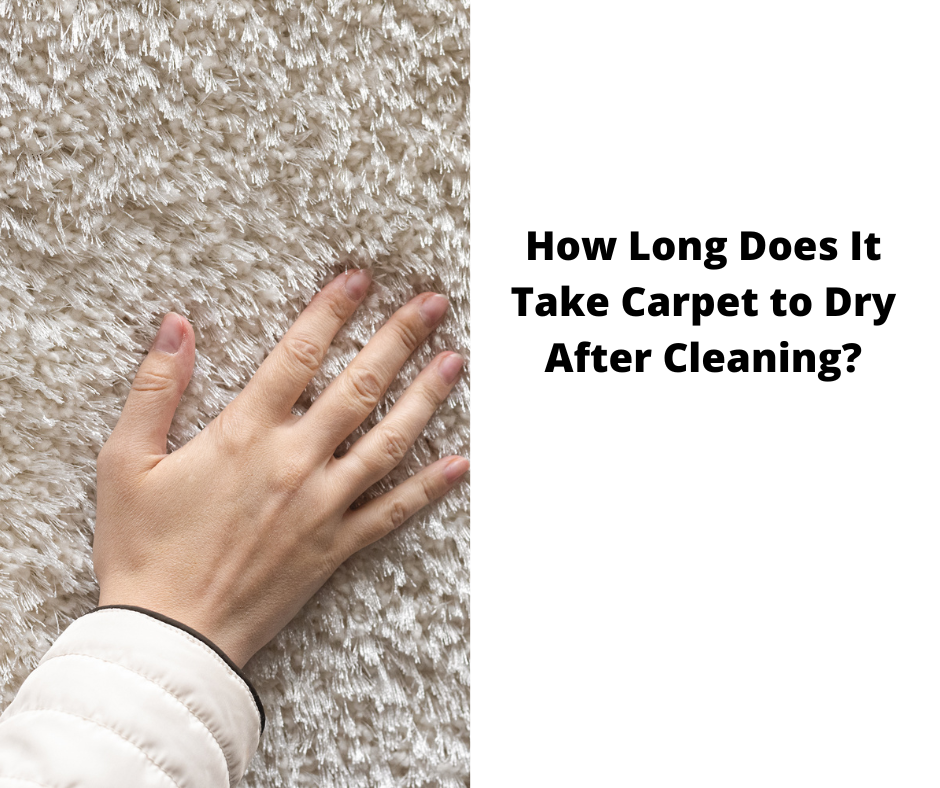
Before you start cleaning your carpet, it’s critical to consider how long it will take to dry. Using HVAC systems and stationary fans is a good way to speed up the drying time. Additionally, using a dehumidifier can greatly reduce the time required for your carpet to dry.
If none of these options works for you, use a fan on your desk or stand to help dry wet carpet. And if you really can’t stand the heat and humidity, use a fan.
Stand Fans or Desk Fans Dry Carpet Faster than An Overhead Ceiling Fan
Overhead ceiling fans do a great job drying a carpet faster than a stand fan or desk fan. They create a full-funnel of air, which helps remove moisture and prevents musty odors. A desk or stand fan will not be as effective, however. A couple of smaller fans on either side of the carpet should be enough to provide adequate air circulation. In a pinch, a desk fan will also do an excellent job of drying carpet, though it won’t be as quick as an overhead fan.
While stand fans and ceiling fans have their pros and cons, ceiling fans offer a more permanent look. They are easier to move from room to room and are less susceptible to damage. But if you don’t want to worry about removing the fan, you should consider ceiling fans. They also are more expensive than a desk and stand fans. They are also much more versatile than a desk and stand fans, which is why many people use both types.
HVAC Systems Reduce Drying Time
HVAC systems reduce drying time after carpet cleaning by lowering indoor temperature. To promote faster drying, heating or air conditioning systems should be set at 75 degrees or lower—alternate heat and air modes for six to eight hours.
If possible, open windows to allow the air to circulate. Open the windows while still cool outside to reduce air conditioning costs and speed up drying. Once the carpet is dry, it is safe to move furniture.
When you’re finished cleaning your carpet, you can turn on fans or place standing fans in rooms that still need to be dried. If the weather is nice, you can also open the windows. If you don’t have access to a heating or air conditioning system, you can use an air mover to speed up the drying process. But if these options are not available, you can always turn on your HVAC system to “Heat” and leave it on for at least a couple of hours.
Using a Towel to Dry Wet Carpet
Wet carpet is difficult to dry, and leaving it alone can cause damage to your flooring and furniture. Even if the water source did not make the carpet wet, it could still cause it to buckle. Leaving a wet carpet to dry on its own can allow mold and mildew to grow. Especially when the carpet is wall-to-wall, drying it yourself can be a major task.
To dry a wet carpet after cleaning, you will need to figure out the source of the water. A broken pipe or leaking roof will make your carpet wet. If this happens, turning on a fan or dehumidifier is a good idea to help draw the moisture out of the air. You can also lay down a rag on the carpet and weigh it down with objects. Be sure to wrap it in waterproof material.
Using a Dehumidifier
While a fan can help cut drying times, a dehumidifier will suck up the moisture. It will take a couple of hours to dry a carpet after it’s been cleaned, so it’s a good idea to set it on high while drying it. Alternatively, a shop vac can suck up any excess water. Whether you use a shop vac or a dehumidifier is a matter of personal preference, but always be sure to empty the fluid canister every hour.
A dehumidifier collects moisture from the air around the carpet and converts it to water. You can place it near the area you want to dry the carpet. If you’re worried about mold or musty smells in your new carpet, you can also use a dehumidifier to dry the damp air. You can set the dehumidifier to run continuously for up to two hours and check it every hour.
Using an Air Conditioner
If you’ve just had your carpet professionally cleaned, you might be wondering how to dry it properly. There are several ways to do this, but heat and air conditioning play a big part. Winter is the best time for drying carpets due to the low RH and constant temperature inside the house. In summer, A/C can slow down the drying process, and a higher SEER rating means it will be less efficient at removing moisture.
If the temperature is below 60 degrees Fahrenheit, the inside of most AC units becomes ice. This ice is so solid that it will not flow into the drain pan. Once melted, this ice will leak into the room and can damage the carpet. If you’re using an AC to dry your carpet, set the thermostat to the highest setting and empty it every few hours. If you want to speed up the process, use a dehumidifier or a window-mounted fan.
Dorothy is the Editor in Chief of Steam Mop List. She’s dedicated to helping people learn how to clean their homes quickly and easily. Dorothy believes cleaning should be fun and rewarding, so everyone can feel confident in their ability to keep their space spick and span. Dorothy enjoys spending time with her family and friends when she’s not writing or editing articles.
Cleaning
How Do You Get Orange Juice Stains Out of Carpet?

The first action you should take is to quickly blot the spill of orange juice. Flip the carpet over and, if possible, soak the affected spot in cold water. If hot water is unavailable, using a solution of soapy water could assist in removing the stain. After the cleaning process, it’s crucial to fully rinse the carpet to ensure no soap residue remains. This method ought to successfully eliminate the stain.
Ammonia
There are several methods for removing stains from carpets. The most effective method is to use an alkaline cleaner, like ammonia to remove dried fruit juices. While you can use a vinegar or hydrogen peroxide solution, they can discolor some types of carpet. The best way to remove a stain is to act fast. For this method, you need to use a solution of 1 part ammonia to 8 parts water. Pour this solution over the stain and blot it thoroughly to remove the remaining particles.
If the stain is still not entirely removed, try applying a laundry stain remover. This product works well to remove orange juice stains and can also be used to clean stains in wool or oriental rugs. Always rinse the carpet well after using this product because it can damage delicate fabrics. The next step is to use a stain remover containing 3% hydrogen peroxide.
Hydrogen Peroxide
If you have a stain on your carpet, you can easily remove it with hydrogen peroxide. This stain-removing product can lift stains out of carpets, and it works well on bright red stains. Just make sure to dilute it with warm water to prevent discoloration. Apply the solution to the affected area with a cloth. Make sure not to rub the solution on the stain, as it can bleach the carpet.
Another way to remove a stain is to use lemon juice or non-bleach liquid dish detergent. Liquid dish detergent is formulated for tough food messes on your dishes so that it can tackle a juice stain in your carpet. Mix the liquid dish detergent with two cups of warm water and blot the stained area using a clean cloth. For a more effective result, use a clear liquid dish detergent; colored liquid dish detergent should be tested on a small patch of the carpet first.
White Vinegar
If you’ve spilled orange juice on your carpet, there are a few ways to remove it. The most popular method is chlorine bleach, which can be found in many cleaning products. However, this is a more intensive method and requires some patience. The trick is to follow the directions on the label of the product. You must be patient to obliterate the stain. If you have more time to spare, you can also try a shop vac.
A hose attachment vacuum cleaner can remove the stain. A bucket of water will also do the trick. Another option is to use a non-abrasive cleaner. Depending on how much orange juice is absorbed, you may need to use a scraper to remove the stain. A mixture of white vinegar and one part water can also work. The key is to blot the stain repeatedly.
Tide to Go
The Tide to Go mini pen is a portable and convenient stain remover for fresh fruit and drink stains. You can keep this in your car, purse, or desk drawer. This stain eraser removes excess residue and works to lift orange juice, cherry, or coffee stains from your carpet and upholstery. For best results, follow the directions on the bottle for the right amount of solution to apply to your carpet or upholstery.
Apply the product to the stain within four to 48 hours. If the stain has not yet been absorbed into the fabric, rub it with a clean white towel and wait for 10 minutes. Repeat this process until the stain is almost gone. Rinse the stain with cool water to remove any soap residue. Repeat as necessary until the stain is gone. Tide to Go to get an orange juice stain out of carpet or upholstery is the best cleaning solution.
Enzymatic Cleaner
You may wonder how to get an orange juice stain out of the carpet using an enzyme cleaner. If you have a bright red stain, hydrogen peroxide may be able to lift the stain and remove it. If you don’t have access to a carpet stain remover, you can try baking soda, salt, or cornstarch. These ingredients are mild, safe for carpets, and can help remove the stain in just a few hours.
A lemon or white vinegar mixture can also be applied directly to the stain. To ensure that the solution does not spread, apply it from the edges into the center of the stain. After 15 minutes, brush the stain out using a clean cloth. Distilled white vinegar and baking soda may be used to remove stains. For best results, follow the manufacturer’s instructions.
Hi, I’m Ellen. I love making cleaning fun and rewarding – so everyone can feel confident in their ability to keep their space spick and span. Our vision is a world where everyone knows how to clean their home. In the meantime, I’ll continue writing Steam Mop List to help make your life a little easier (and hopefully a little more fun).
Cleaning
How to Clean Dried Cat Urine Stains
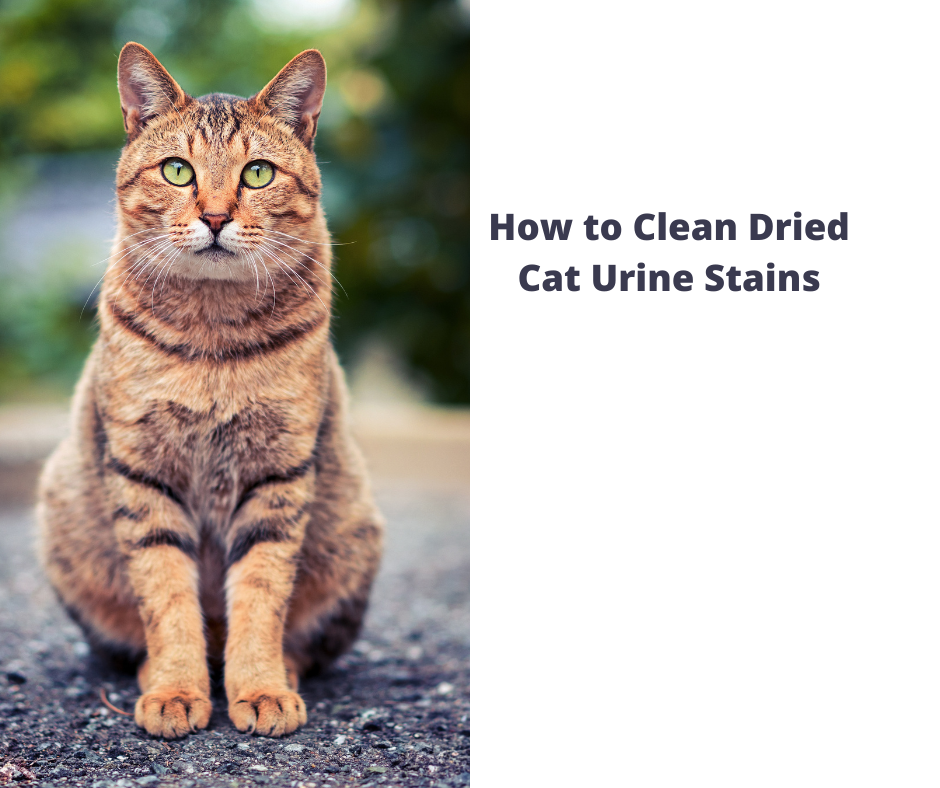
Maintaining a clean home increases comfort levels. It’s easier to relax in an environment where everything is neatly arranged and devoid of unpleasant smells. It’s important to act swiftly in cleaning up spills to prevent them from escalating into bigger problems. The smell of rotten milk is particularly challenging to remove because of its strong odor.
Cat urine is also challenging because it is very focused. Pets are part of the family, but accidents happen. The key is to clean them up quickly and thoroughly to prevent odors from lingering.
How to Clean Dried Cat Urine Stains
As any cat lover knows, these furry creatures have a reputation for being aloof and independent. However, this independence results from evolutionary adaptations that allow cats to thrive in arid climates. Cats originated in the deserts of Africa and Asia, and to survive in these harsh conditions; they had to evolve to absorb more moisture from their food. This is why cats do not drink as often as dogs do, and it also explains why their urine is more concentrated and has a strong odor. If your cat has an accident on carpets or upholstery, acting quickly is the best way to remove the stain and the lingering smell.
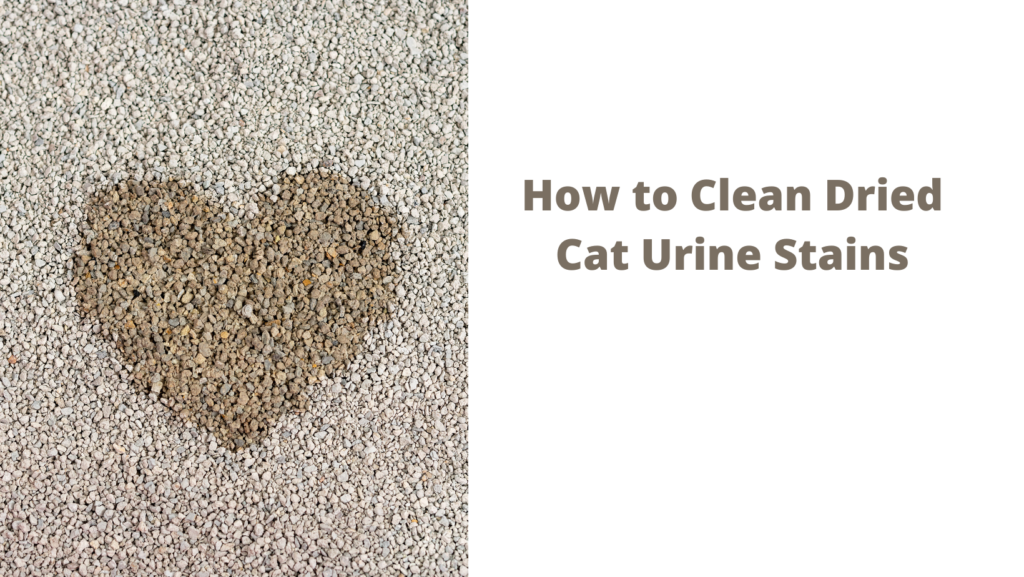
- Blot up as much urine as possible with a clean cloth or paper towel.
- Apply a pet-specific cleaner or a solution of equal parts water and vinegar to the affected area.
- Work the cleaner into the fabric with a brush, then blot again to remove any remaining moisture.
- Let the area dry completely before vacuum l cleaning or using any other products.
Following these simple steps, you can quickly and easily remove even the most stubborn pet stains.
How to Remove Cat Urine Stains & Odors from Carpet – Method 1
If your cat has an accident and urinates on your carpet, cleaning the stain as soon as possible is essential.
- In a spray bottle, combine 1½ cup warm water with ½ cup white vinegar.
- Blot up as much urine as possible with a clean towel.
- Pour the vinegar solution over the afflicted area and let it sit for 5 minutes. Vinegar is an excellent natural solvent that also destroys germs!
- To dry it, blot the remaining dampness with a clean cloth until completely dry.
- After the area has dried, sprinkle a thick layer of baking soda over the afflicted region and leave it to sit overnight. In the morning, vacuum any remaining baking soda away.
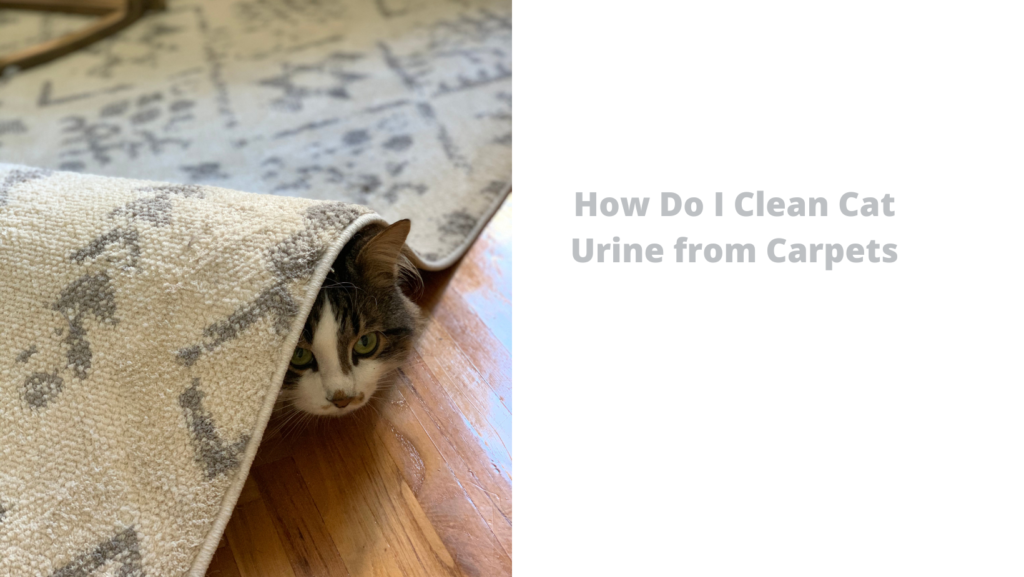
How Do I Clean Cat Urine from Carpets – Method 2
Accidents happen to everyone’s pets. When treating pet stains, the sooner you act, the better. With that in mind, here is a step-by-step tutorial on how to remove cat urine from your carpet or furniture:
1. To eliminate as much of the urine as feasible, use a clean cloth to blot the spot.
2. Apply an enzymatic cleaner (available at pet shops) to the afflicted region. Enzyme cleaners aid in the breakdown of cat urine acid to eliminate its noxious odor.
3. Even if the bottle says “only 10-15 minutes,” leave it for at least 10-15 minutes.
4. Blot up the cleaner with a clean cloth, making sure to use a clean section of the cloth or new cloth for each blot to avoid reinstalling the urine back to the location.
5. Soak a clean cloth in a bowl of warm water and use it to blot the spot until it is no longer visible gently.
6. Blot the dampened region until it is no longer moist with a clean towel.
7. Repeat as needed.
How Do You Get Old Cat Urine Stains Out?
Use an old towel to absorb as much of the cat pee as possible, then dispose of it. Sprinkle baking soda over the affected region and leave for 10 minutes. Pour some vinegar on the fizzing baking soda and blot the liquid with a new cloth after a few seconds.
How Do You Get Dried Cat Urine out Of Floor?
Remove the stain from your carpeting with a solution of 1 part hydrogen peroxide and 9 parts water. Cover it with a clean cloth soaked in hydrogen peroxide, followed by plastic wrap weighted down with a book if necessary. Allow it to sit overnight or for at least 8 hours; the hydrogen Peroxide should remove any stains and relieve the odor of
Does Vinegar and Baking Soda Remove Cat Urine from Carpet?
One of the simplest methods to remove dog pee stains from the carpet is to use white vinegar. Clean the spot with a sponge and soapy water. Dry the region with paper towels if necessary. You may need to repeat application treatments several times to eliminate the smell. Baking soda and peroxide are two other solutions that you might want to try. Simply sprinkle the baking soda on the carpet and let it sit for a few hours before vacuuming. Or, soak up as much dog pee from the carpet as you can with paper towels and then pour a 50/50 mixture of vinegar and water onto the spot. Let it sit for 30 minutes, then blot dry with paper towels. Be sure to also check out our guide on removing pet stains from carpets for more tips.
Do Cat Pee Stains Come Out?
Use an enzyme detergent to wash the soiled garments in your washing machine, if possible. Following that, air dry your clothing. Adding one pound of baking soda to the laundry or utilizing a cycle with only a cup of white vinegar and no detergent before washing is recommended, followed by a second cycle using regular detergent.
Does OxiClean Get Rid of Cat Urine?
OxiCleanVSR is a laundry booster that can also be used to clean various flooring, including ceramic tile, grout, vinyl plank, and linoleum. It’s chlorine-free and can be used to remove cat urine stains.
Does Vinegar Break Down Cat Urine?
Cleaning the region with vinegar and applying an enzyme treatment destroys uric acid and eliminates cat smells. Vinegar and enzyme cleansers are effective on all types of flooring, including hardwood floors and carpets.
How Do You Get Old Black Urine Stains out Of Hardwood Floors?
If you have a stain on your wooden floor, use vinegar and baking soda paste to remove it after an hour. You may also blot black stains by applying hydrogen peroxide to the affected area for many hours. If everything else fails, scrape the stained surface, sand it down, and finish the hardwood floors with naphtha or another similar product.
How Do You Get Cat Urine out Of Clothes?
If the clothing is machine-washable, blot the area with a paper towel to remove as much moisture as possible. Then pretreat the stain with a laundry detergent that contains enzymes, such as Tide Stain Release or Persil ProClean 2-in-1. After pretreating, wash the clothing in the hottest water that is safe for the fabric. You may also add one cup of white vinegar to the wash cycle. If the clothing is not machine-washable, take it to a dry cleaner.
How Do You Remove Cat Urine from Leather?
Start by wiping down the affected area with a clean, damp cloth. If the stain is still visible, mix one part white vinegar with one part water and apply it to the leather with a sponge. Rub the area in a circular motion until the stain begins to fade. Wipe it clean with a damp cloth and dry it with a soft, absorbent towel. You may need to repeat this process several times to remove the stain. If the vinegar solution doesn’t work, you can try using rubbing alcohol.
How Do You Remove Cat Urine from Upholstery?
To remove cat urine from upholstery, mix one part white vinegar with one part water and apply it to the affected area with a sponge. Rub the area in a circular motion until the stain begins to fade. Wipe it clean with a damp cloth and dry it with a soft, absorbent towel. You may need to repeat this process several times to eradicate the stain. If the vinegar solution doesn’t work, you can try using rubbing alcohol.
How Do You Get Cat Urine out Of Concrete?
The best way to remove cat urine from concrete is to use a mixture of one part white vinegar and two parts water. Apply it to the affected area with a sponge and rub it in a circular motion until the stain begins to fade. Wipe it clean with a damp cloth and dry it with a soft, absorbent towel. You may need to repeat this process several times to remove the stain.
How Do You Get Cat Urine out Of a Mattress?
To remove cat urine from a mattress, mix one part white vinegar with two parts water and apply it to the affected area with a sponge. Rub the area in a circular motion until the stain begins to fade. Wipe it clean with a damp cloth and dry it with a soft, absorbent towel. You may need to repeat this process several times to remove the stain completely. If the vinegar solution doesn’t work, you can try using rubbing alcohol.
How Do You Get Old Cat Urine out Of Hardwood Floors?
To eliminate the odor of vinegar, combine one cup of vinegar with a warm water-filled pail and a few drops of grapefruit oil. Concentrate on the most visible locations when scrubbing the floor with this safe cleaning solution. The aroma and stains should fade as you wash.
How Do You Get Urine Stains out Of Hardwood Floors?
The most cost-effective and efficient way to remove animal urine from hardwood floors is to use a solution of 3% hydrogen peroxide and water. Simply dampen the rag or soft, absorbent cloth, such as felt, and apply it to the location. Allow the rag to rest for a few hours so that the urine stain and odor are removed
What Enzymes Break Down Cat Urine?
Protease, lipase, amylase, cellulase, and urease are all enzymes found in pet urine cleaners. Bacteria produce these enzymes to help them digest the pee.
Is Cat Urine Smell Permanent?
Cat pee stinks for a long time. It’s one of the most persistent odors imaginable, with a tendency to linger no matter how much you try to scrub the stain or cover up the foul odor with air fresheners or potpourri.
Will Simple Green Remove Cat Urine?
Simple Green® Cat Stain & Odor Remover is a safe and effective way to eliminate cat urine, feces, vomit, scent-marking, and dirt. Use on various surfaces, including carpets, rugs, bedding, upholstery, cages, flooring, and carriers.
What Enzymes Break Down Cat Urine?
Protease, lipase, amylase, cellulase, and uriase are just a few enzymes found in pet urine cleaners. Bacteria produce these enzymes to aid them to break down the urine into nutrients they can consume.
Dorothy is the Editor in Chief of Steam Mop List. She’s dedicated to helping people learn how to clean their homes quickly and easily. Dorothy believes cleaning should be fun and rewarding, so everyone can feel confident in their ability to keep their space spick and span. Dorothy enjoys spending time with her family and friends when she’s not writing or editing articles.
Carpet
How Often Should a Landlord Replace Carpet?

How Often Should Property Owners Replace Carpets? It’s the duty of property owners to keep their rental properties in top-notch condition. This responsibility covers updating appliances, ensuring the plumbing is working efficiently, and keeping the floors, including carpets, in good condition. Carpets are frequently selected by property owners due to their affordability and ease of installation, but it leads to the question: How often is it necessary to replace them? The answer may surprise you.
Most experts recommend replacing carpet every five to seven years, regardless of how well it’s been maintained. Of course, if there are significant stains or damage, you may need to replace it sooner. And if they are in high-traffic areas, the landlord may need to replace the carpet more frequently. Ultimately, it’s essential to inspect the carpet by the landlord regularly and decide based on its condition.
So there you have it: most landlords should replace their carpet every five to seven years. By following this advice, landlords can help ensure that your rental property remains in good condition for years to come.
How Often Should a Landlord Replace Carpet?
Concerning carpeting, there is a big difference between quality and cheap products. A good quality carpet can last up to 10 years, while something cheap might only last three years. In addition, landlords often redecorate as a routine at the end of each tenancy.
This might just involve a few paint touch-ups, or it could mean a fresh, new rug. Either way, it is essential to consider the long-term investment when choosing the carpet for your home. Not only will you save money in the long run, but you will also have a product that looks great and lasts many years.
How Often Does a Landlord Have to Replace Carpet in BC?
“As stated in the Residential Tenancy Policy Guidelines the useful life of carpets is expected to be 10 years, and after that time, they are considered to be completely depreciated and of no value.” Source: http://www.housing.gov.bc.ca/rtb/decisions/2015/06/062015_Decision6555.pdf
Is It a Landlord’s Responsibility to Replace Carpets?
A decent carpet should last ten years or more if properly cared for in a rental house. The landlord is generally responsible for replacing a worn-out carpet, especially if the tenant has not damaged it.
Do Landlords Have to Paint Between Tenants Bc?
The landlord is responsible for painting the interior of the rental unit at reasonable intervals. The tenant cannot be required as a condition of tenancy to paint or repair the premises, only where necessary due to damages for which the tenant is responsible.
What Is Normal Wear and Tear on A Rental Property BC?
Normal wear and tear is the deterioration of a rental property over time, even though the tenant has been maintaining it. For example, mild scratches on a kitchen work surface are likely normal wear and tear.
Can I Claim for New Carpets in My Rental Property?
You must report the true cost of the item to you and the cost of replacing it with a comparable quality or value. For example, if you replace a mid-range carpet, you can only claim for the expense of doing so.
How Often Should a Landlord Replace Laminate Flooring?
Laminate flooring is a popular choice for rental properties as it is easy to clean and maintain. It is also more durable than carpets, so it does not need to be replaced as often. Most experts recommend replacing laminate flooring every 10-15 years.
How Often Should a Landlord Replace Vinyl Flooring?
Vinyl flooring is another popular choice for rental properties as it is also easy to clean and maintain. It is also more durable than carpets, so it does not need to be replaced as often. Most experts recommend replacing vinyl flooring every 10-15 years.
How Do I Get My Landlord to Replace the Carpet?
Landlords may be obligated to replace carpets when uneven or damaged. You might begin by contacting the landlord and following up with a written complaint.
How Long Does Cheap Carpet Last?
Inexpensive carpeting, like apartment-grade carpets, will typically last anywhere from one to five years. A medium-grade carpet will endure between 5 to 15 years. On average, the finest of the best carpet on the market lasts for around 15 to 25 years.
How Do You Prorate Carpet?
You can prorate carpet by measuring the room’s square footage and multiplying it by the number of years the carpet is expected to last. For example, if you have a 10×10 room and the carpet is expected to last 10 years, you would need 100 square feet of carpet.
What Are Landlords Responsible for In Bc?
The Residential Tenancy Act (RTA) states that landlords must keep their rental units in a good state of repair, and they are required to meet housing, safety, and building codes as prescribed by law.
How Often Can a Landlord Inspect a Property in Bc?
Once a month, the property is inspected by the landlord and any necessary repairs, maintenance or cleaning are completed
Can a Landlord Charge a Cleaning Fee in Bc?
The landlord may charge a fee if a tenant wants to move between units in a multi-tenanted building. This must be included in the tenancy agreement, and the cost cannot exceed $15 or 3% of monthly rent, whichever is greater.
What can a landlord deduct from the deposit?
What are the most frequent reasons for deposit deductions? Unpaid rent at the end of a tenancy. Unpaid bills after a tenancy. Property belonging to the landlord that has been stolen or lost. Indirect property damage caused by negligence and lack of upkeep. Direct damage to the property and its contents (owned by the landlord) Indirect damage that results from the tenant’s negligence.
How long does a landlord have to return a deposit in Bc?
A landlord must return the deposit within 21 days after the tenancy ends and the tenant has moved out unless there is damage to the rental unit or the tenant owes rent. If there is damage, the landlord can withhold money from the deposit to cover the cost of repairs. If the tenant owes rent, the landlord can keep all or part of the deposit to cover the unpaid rent.
Can the Landlord Do Renovations While Occupying Bc?
Renovations and repairs may be done without disrupting tenancies if they are limited in scope.
Can landlords charge you for cleaning?
Is it legal for a landlord to charge tenants for a professional cleaning service at the end of their tenancy at the rental property? The simple answer is no. In fact, according to the Tenant Fees Act 2019, landlords are not allowed to charge tenants for end-of-tenancy cleaning services.
How long should carpets last in a rental?
Most landlords inspect their rental property’s carpets every five years, much like with general redecorating. The age of the carpet you bought is important – a higher grade carpet may last up to 10 years, while a lower quality one might only survive three to five years.
Is replacing carpet a repair or improvement?
An improvement is a cost for any project that improves your property, restores it, or adapts it to a new or different use. Carpet replacement is classified as an upgrade and depreciated over five years (nine years under the modified system).
Is carpet replacement a rental expense?
If the carpet is tacked down, it is valued as the personal property and depreciated over five years. However, if the carpet in a residential rental property is fastened down, it will be considered part of the structure and depreciated for a whopping 27.5 years.
Are scratches on wood floors normal wear and tear?
Hardwood Floors: Hardwood flooring has an average lifespan of 25 years. Such flooring wear and tear is typical, as are minor surface scratches. However, badly scratched hardwood floors or missing pieces of wood would be considered tenant damage.
What type of flooring is best for rental property?
Although vinyl flooring may be used in almost every room of your rental property, it’s most popular in living rooms and bedrooms. Vinyl is also very moisture resistant, making it ideal for kitchens and bathrooms.
Can tenants decorate rented property?
Is it legal to decorate a leased apartment? You should never redecorate a rental house unless you ask your landlord’s permission first. You might inquire about allowing you to decorate before you begin your tenancy if you see a property while the current tenants are still there.
Who is responsible for painting landlord or tenant?
Who Is Responsible For Painting: Is It The Landlord Or The Tenant? In most leases, the responsibility for painting usually falls to the landlord. Only with written permission from the landlord may a tenant paint.
Dorothy is the Editor in Chief of Steam Mop List. She’s dedicated to helping people learn how to clean their homes quickly and easily. Dorothy believes cleaning should be fun and rewarding, so everyone can feel confident in their ability to keep their space spick and span. Dorothy enjoys spending time with her family and friends when she’s not writing or editing articles.
-

 Cleaning20 hours ago
Cleaning20 hours agoHow Do You Get Orange Juice Stains Out of Carpet?
-

 Cleaning4 weeks ago
Cleaning4 weeks agoHow To Expertly Clean And Maintain Hardwood Or Wooden Floors After A Latte Spill
-
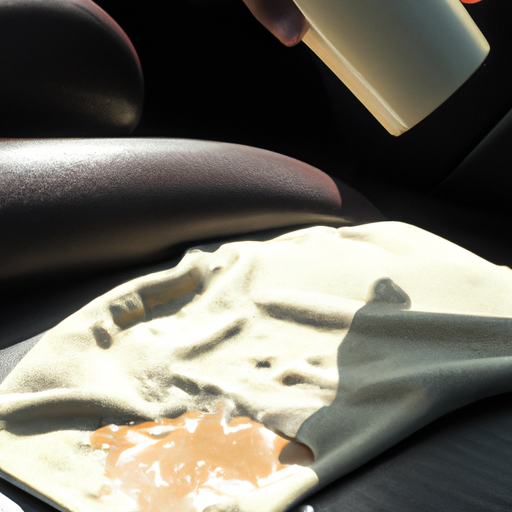
 Cleaning4 weeks ago
Cleaning4 weeks agoHow To Detect And Effectively Clean Latte Stains In Unconventional Spots
-

 Cleaning4 weeks ago
Cleaning4 weeks agoHow To Safely And Efficiently Remove Latte Stains From Delicate Suede Materials
-
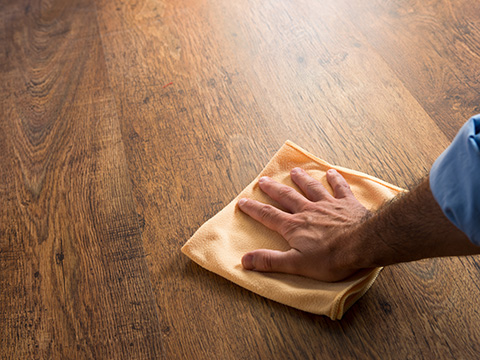
 Steam Mop1 day ago
Steam Mop1 day agoCan You Use a Steam Mop on Vinyl Plank Flooring?
-
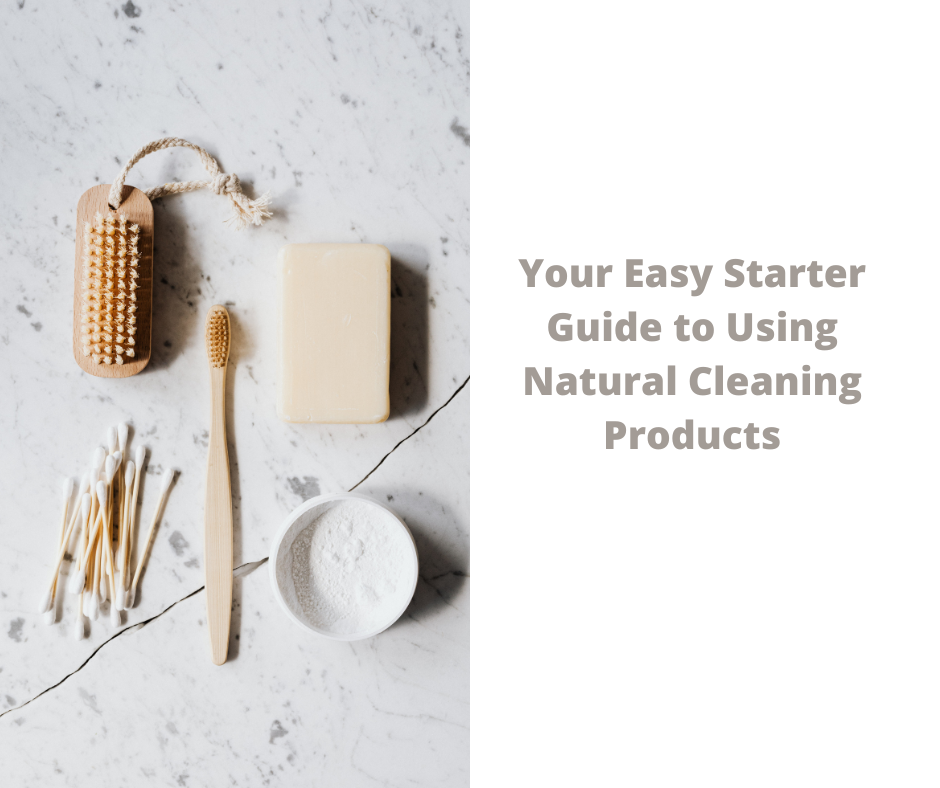
 Beginners Guides1 day ago
Beginners Guides1 day agoYour Easy Starter Guide to Using Natural Cleaning Products
-

 Beginners Guides2 days ago
Beginners Guides2 days agoHow to Use a Steam Mop to Clean the Floor
-
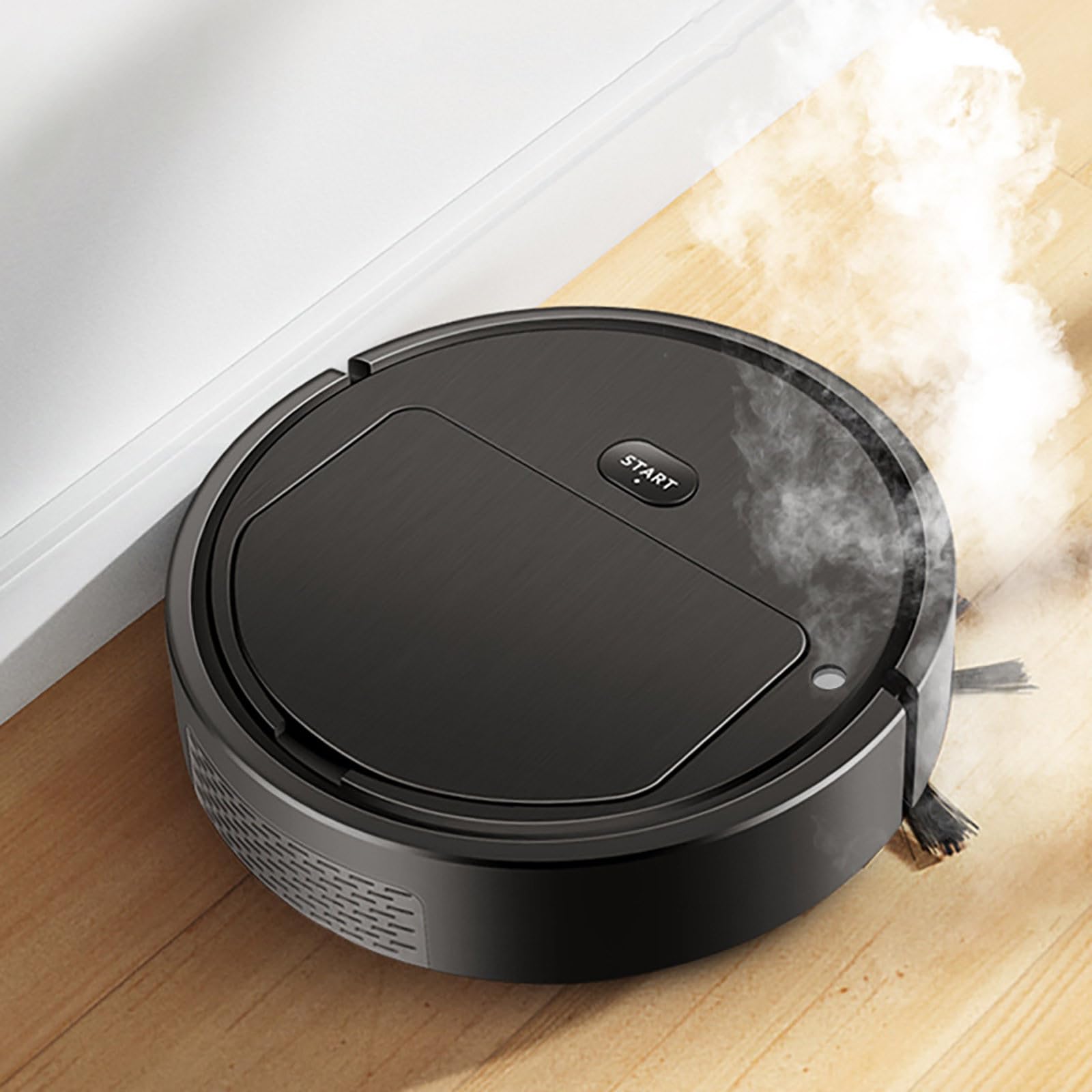
 Reviews3 weeks ago
Reviews3 weeks agoAZXY Robot Vacuum Cleaner Review (2023)



